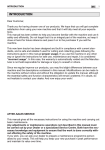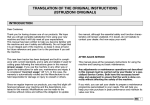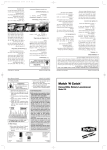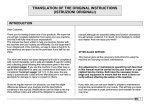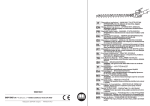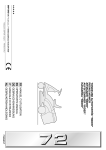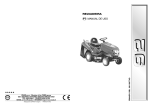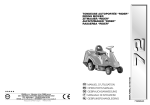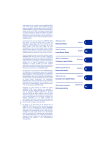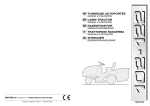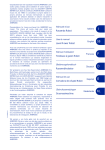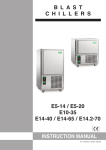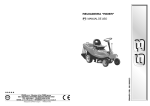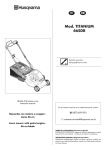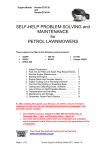Download CG um NJ92/07
Transcript
90-92 AUTOPORTÉE FR TONDEUSE MANUEL D’UTILISATION ATTENTION! - Avant d’utiliser la machine, lire attentivement le présent manuel. EN LAWN-TRACTOR OWNER’S MANUAL WARNING! Read this manual carefully before using the machine. DE RASENTRAKTOR GEBRAUCHSANWEISUNG ACHTUNG! - Bevor man die Maschine verwendet lese man das vorliegende Handbuch sorgfältig durch. RASAERBA IT TRATTORINO MANUALE DI ISTRUZIONI ATTENZIONE: prima di utilizzare la macchina, leggere attentamente il presente manuale. NL ZITMAAIER GEBRUIKERSHANDLEIDING LET OP! – Vooraleer de machine te gebruiken, lees aandachtig deze handleiding. INTRODUCTION EN 1 INTRODUCTION Dear Customer, Thank you for having chosen one of our products. We hope that you will get complete satisfaction from using your new machine and that it will fully meet all your expectations. This manual has been written to help you become familiar with the machine and use it safely and efficiently. Do not forget that it is an integral part of the machine, so keep it close at hand for future reference and pass it on to the purchaser if you sell the machine. This new lawn tractor has been designed and built in compliance with current standards, and is safe and reliable if used for cutting and collecting grass following the instructions given in this manual (proper usage). If you use the machine in any other way or ignore the instructions for safe use, maintenance and repair, it is considered "incorrect usage". In this case, the warranty is automatically voided and the Manufacturer is not held responsible for damage or injury to oneself or others. Since we regular improve our products, you may find slight differences between your machine and the descriptions contained in this manual. Modifications can be made to the machine without notice and without the obligation to update the manual, although the essential safety and function characteristics will remain unaltered. If in doubt, do not hesitate to contact your dealer. And now enjoy your work! AFTER-SALES SERVICE This manual gives all the necessary instructions for using the machine and carrying out basic maintenance. Any adjustments or maintenance operations not described in this manual must be carried out by your Dealer or a specialized Service Centre. Both have the necessary knowledge and equipment to ensure that the work is done correctly without affecting the safety of the machine. If you wish, you can ask your dealer to prepare a maintenance programme personalised to your needs. This will help you keep your new purchase in peak performance and maintain its value over time. 2 EN TABLE OF CONTENTS TABLE OF CONTENTS 1. SAFETY .................................................................................................................... 3 Regulations for using the machine safely 2. IDENTIFICATION OF THE MACHINE AND COMPONENTS ................................ 7 How to identify the machine and its main components 3. UNPACKING AND ASSEMBLY .............................................................................. 9 How to remove the packing and assemble loose parts 4. CONTROLS AND INSTRUMENTS ....................................................................... 12 Position and functions of all the controls 5. HOW TO USE THE MACHINE .............................................................................. 16 Instructions for working efficiently and safely 5.1 Safety recommendations ................................................................................ 16 5.2 Why the safety devices cut in ......................................................................... 16 5.3 Preliminary operations before starting work ..................................................... 17 5.4 Using the machine .......................................................................................... 19 5.5 Using on slopes .............................................................................................. 26 5.6 Transporting the machine ............................................................................... 27 5.7 Lawn maintenance ........................................................................................... 27 6. MAINTENANCE ..................................................................................................... 29 All the information for maintaining the machine in peak efficiency 6.1 Safety recommendations ................................................................................ 29 6.2 Programmed maintenance ............................................................................... 29 6.3 Checks and adjustments ................................................................................ 32 6.4 Dismantling and replacing parts ..................................................................... 33 6.5 Information for Service Centres ..................................................................... 35 7. TROUBLESHOOTING............................................................................................. 37 A help in quickly solving problems 8. ACCESSORIES ON REQUEST ............................................................................ 39 A description of the accessories available for special requirements 9. SPECIFICATIONS .................................................................................................. 40 A summary of the main specifications of your machine SAFETY EN 3 1. SAFETY 1.1 HOW TO READ THE MANUAL Some paragraphs in the manual containing important information regarding safety and operation are emphasized in the following ways: NOTE IMPORTANT or These give details or further information on what has already been said, in the aim to prevent damage to the machine. ! WARNING! Non-observance will result in the risk of injury to oneself or others. ! DANGER! Non-observance will result in the risk of serious injury or death to oneself or others This manual describes various versions of the machine, which mainly differ as follows: – type of transmission: with either mechanical gear change or hydrostatic continuous speed adjustment. The models with hydrostatic transmission are identified by the word "HYDRO" on the identification label (☛ 2.1); – the inclusion of components or accessories which are not widely available; – special equipment fitted. The symbol ➤ highlights all the differences in usage and is followed by the indication of the version to which it refers. The symbol “ ☛ ” refers to another part of the manual where further information can be found. NOTE Positions on the machine, such as “front”, “back”, “left” or “right” hand side, refer to the direction of forward travel. IMPORTANT For all operations regarding the use and maintenance of the engine or the battery not described in this manual, refer to the relevant manuals which form an integral part of all the documentation supplied with the machine. 4 SAFETY EN 1.2 GENERAL SAFETY REGULATIONS ! WARNING! Read carefully before using the machine. A) TRAINING 1) Read the instructions carefully. Be familiar with the controls and how to use the equipment properly. 2) Never let children or people unfamiliar with these instructions use the machine. Local regulations can restrict the age of the user. 3) Never mow while people, especially children, or pets are nearby. 4) Keep in mind that the operator or user is responsible for accidents or hazards occurring to other people or their property. 5) Do not carry passengers. 6) All drivers should seek and obtain professional and practical instruction. Such instruction should emphasise: – the need for care and concentration when working with ride-on machines; – you cannot use the brake to regain control of a ride-on machine sliding down a slope. The main reasons for loss of control are: – insufficient wheel grip; – overspeeding; – inadequate braking; – the type of machine is unsuitable for its task; – unawareness of the effect of ground conditions, especially slopes; – incorrect hitching and load distribution. B) PREPARATION 1) While mowing, always wear sturdy footwear and long trousers. Do not operate the equipment barefoot or wearing open sandals. 2) Thoroughly inspect the area where the equipment is to be used and remove all objects which can be ejected from the machine. 3) DANGER! Petrol is highly flammable: – store fuel in containers specifically designed for this purpose; – refuel outdoors only and do not smoke while refuelling; – add fuel before starting the engine. Never remove the cap of the fuel tank or add petrol while the engine is running or when the engine is hot; – if you spill petrol, do not start the engine and move the machine away from the area of spillage. Do not create any source of ignition until the petrol vapours have evaporated; – put back and tighten all fuel tank and container caps securely. 4) Replace faulty silencers. 5) Before use, always inspect the machine to check that the blades, blade bolts and cutter assembly are not worn or damaged. Replace worn or damaged blades and bolts in sets to preserve balance. 6) On multi-bladed machines, remember that the rotation of one blade can cause other blades to rotate. C) OPERATION 1) Do not start the engine in a confined space where dangerous carbon monoxide fumes can collect. 2) Mow only in daylight or good artificial light. 3) Before starting the engine, disengage the blades and shift into neutral. 4) Do not use on slopes of more than 10° (17%). SAFETY 5) Remember there is no such thing as a “safe” slope. Travelling on grass slopes requires particular care. To guard against overturning: – do not stop or start suddenly when going up or downhill; – engage the drive slowly and always keep the machine in gear, especially when travelling downhill; – machine speeds should be kept low on slopes and during tight turns; – tay alert for humps and hollows and other hidden hazards; – never mow across the face of the slope. 6) Use care when pulling loads or using heavy equipment: – use only approved drawbar hitch points; – limit loads to those you can safely control; – do not turn sharply. Use care when reversing; – use counterweight(s) or wheel weights whenever advised in the instructions manual. 7) Disengage the blades before crossing surfaces other than grass. 8) Never use the machine with damaged guards, or without the safety protective devices in place. 9) Do not change the engine governor settings or overspeed the engine. Operating the engine at excessive speed can increase the risk of personal injury. 10) Before leaving the driving seat: – disengage the blades and lower the attachments; – go into neutral and apply the parking brake; – stop the engine and remove the ignition key. 11) Disengage the blades, stop the engine and remove the ignition key: – before clearing blockages or unclog- EN 5 ging the collector channel; – before cleaning, checking or servicing the machine; – after striking a foreign object. Inspect the machine for damage and make repairs before restarting and operating the machine; – If the machine starts to vibrate abnormally (check for the causes immediately). 12) Disengage the blades for transport or whenever they are not in use. 13) Stop the engine and disengage the blades: – before refuelling; – before removing the grass-catcher. 14) Reduce the throttle during engine run-out. If the engine is provided with a shut-off valve, cut off the fuel when you have finished mowing. D) MAINTENANCE AND STORAGE 1) Keep all nuts, bolts and screws tight to be sure the equipment is in safe working condition. 2) Never store the equipment with petrol in the tank inside a building where fumes may reach an open flame or spark. 3) Allow the engine to cool before storing in any enclosure. 4) To reduce fire hazards, keep the engine, silencer, battery compartment and petrol storage area free of grass, leaves, or excessive grease. 5) Check the grass-catcher frequently for wear or deterioration. 6) Replace worn or damaged parts for safety purposes. 7) If the fuel tank has to be drained, this should be done outdoors. 8) On multi-bladed machines, remember that the rotation of one blade can cause other blades to rotate. 9) When the machine is to be stored or left unattended, lower the cutting deck. 6 SAFETY EN 1.3 SAFETY LABELS Your machine must be used with care. This is why labels with illustrations have been placed on the machine, to remind you of the main precautions to take during use. These labels are to be considered an integral part of the machine. Should a label come off or become illegible, contact your dealer to replace it. Their meaning is explained below. 1 Warning: Read the instructions before operating this machine. 2 Warning: Disconnect the ignition key and read the instructions before carrying out any repair or maintenance work. 1 2 3 4 5 6 3 Danger! Ejected objects: Do not operate without the stoneguard or grass-catcher in place. 4 Danger! Ejected objects: Keep bystanders away. 5 Danger! Machine rollover: Do not use this machine on slopes steeper then 10°. 6 Danger! Dismemberment: Make sure that children stay clear of the machine at all time when engine is running. 7 7 Danger of cutting yourself. Blades in movement. Do not put hands or feet near or under the opening of the cutting plate. A kit for towing a small trailer is available on request. This accessory is to be fitted following the instructions provided. When using the towing kit, do not exceed the recommended loads stated on the label and follow the safety instructions (☛ 1.2, C-6). max 980 N (100 kg) 1.4 REGULATIONS FOR TOWING max 245 N (25 kg) IDENTIFICATION OF THE MACHINE AND COMPONENTS EN 2. IDENTIFICATION OF THE MACHINE AND COMPONENTS 2.1 IDENTIFICATION OF THE MACHINE The label located near the battery housing has the essential data of each machine. 1. Acoustic power level according to directive 2000/14/CE 2. Conformity mark according to directive 98/37/EEC 3. Year of manufacture 4. Engine speed in r.p.m (if indicated) 5. Type of machine 6. Serial number 7. Weight in kg 8. Name and address of manufacturer 9. Type of transmission (if indicated) 8 5 4 7 LWA min-1 ✍ kg dB S/N Write your machine’s serial number here (6) 3 9 6 2 19 18 1 2.2 IDENTIFICATION OF MAIN COMPONENTS The main components of the machine have the following functions: 11. Cutting deck: this is the guard housing the rotating blades. 12. Blades: these are what cut the grass. The wings at the ends help convey the cut grass towards the collector channel. 16 17 13. Collector channel: this is the part connecting the cutting deck to the grasscatcher. 14. Grass-catcher: as well as collecting 11 12 13 15 14 7 8 EN IDENTIFICATION OF THE MACHINE AND COMPONENTS the grass cuttings, this is also a safety 16 element that stops any objects drawn up by the blades from being thrown outside of the machine. 15. Stone-guard or deflector (optional): this can be fitted in place of the grasscatcher and prevents objects drawn up by the blades from being thrown outside of the machine. 17 11 19 12 18 15 14 13 16. Engine: this moves the blades and drives the wheels. Its specifications and regulations for use are described in a specific manual. 17. Battery: provides the energy for starting the engine. Its specifications and regulations for use are described in a specific manual. 18. Driving seat: this is where the machine operator sits. It has a sensor connected to safety devices for detecting the presence of the operator. 19. Regulation and safety labels: give reminders on the main regaulations for working safely, each of which is explained in chapter 1. UNPACKING AND ASSEMBLY EN 9 3. UNPACKING AND ASSEMBLY For storage and transport purposes, some components of the machine are not installed in the factory and have to be assembled after unpacking. Follow the instructions below. IMPORTANT The machine is supplied without engine oil or fuel. Before starting the engine, fill with oil and fuel following the instructions given in the engine manual. 3.1 UNPACKING When unpacking the machine, take care to gather all individual parts and fittings, and do not damage the cutting deck when taking the machine off the pallet. The packaging contains: – the machine; – the steering wheel; – the seat; – the front bumper (if provided); – the battery; – the grass-catcher (with instructions); – an envelope containing: – the instruction manuals and documents, – nuts and bolts including a pin for locking the steering wheel, – starter keys and a spare 10A fuse. NOTE To prevent damage to the cutting deck, raise it to its maximum height and take utmost care when taking the machine off the pallet. ➤ On hydrostatic drive models: to make it easier to move or take the machine off the pallet, put the transmission disengagement lever in position «B» (☛ 4.33). 3.2 FITTING THE STEERING WHEEL 1 Put the machine on a flat surface and straighten up the front wheels. Fit the steering wheel (1) onto the protruding shaft (2) with the spokes directed towards the seat. Line up the hole on the steering wheel hub 2 3 10 UNPACKING AND ASSEMBLY EN with the hole on the shaft and insert the pin (3) using a hammer. Make sure the end comes right through to the opposite side. NOTE To avoid damage to the steering wheel, use a punch or a screwdriver of the same size as the pin when hammering it through the hole. 3.3 FITTING THE SEAT 2 Mount the seat (1) on the plate (2) using the screws (3). 3 3 1 3.4 MOUNTING THE FRONT BUMPER (if provided) 2 Mount the front bumper (1) on the bottom of the frame (2) using the four screws (3). 1 3 3.5 ACTIVATING AND CONNECTING THE BATTERY The battery (1) is housed behind the engine and secured with an elastic tie-rod (2). 1 ➤ Acid battery: ! WARNING! Battery acid is corrosive and polluting. Wear protective gloves and goggles when handling the UNPACKING AND ASSEMBLY battery and dispose of the battery in accordance with the regulations in force. EN 11 3 4 Unfasten the elastic tie rod (2) and remove the battery and the guard (3). Pour the electrolytic solution (4) (acid not supplied: specific weight 1.280 or 31.5° Baumé) up to the indicated level, distributing it evenly among the six cells. 5 Close the six caps (5) supplied and charge the battery. Put the battery back on the machine. The elastic tie-rod (2) should be positioned behind the battery filler caps (5). IMPORTANT After activating the battery, always charge the battery completely with the help of your dealer, who will have all the right equipment. The battery charger is NOT able to charge the battery for the first time after activation. First connect the red wire (6) to the positive 6 pole (+) and then the black wire (7) to the negative pole (–), using the screws supplied as shown. Apply silicone grease to the terminals and check that the protective cap for the red wire (6) is in place. 1 2 7 IMPORTANT To prevent the safety device in the electronic circuit board from cutting in, never start the engine until the battery is fully charged! 12 CONTROLS AND INSTRUMENTS EN 4. CONTROLS AND INSTRUMENTS 4.7 4.3 4.6 B 4.5 4.1 4.2 A A B 4.8 4.4 4.9 4.1 STEERING WHEEL Turns the front wheels. 4.2 THROTTLE This regulates the engine's r.p.m. The positions are indicated on a plate showing the following symbols: «CHOKE» cold starting «SLOW» for minimum engine speed «FAST» for maximum engine speed – The «CHOKE» position enriches the mixture so must only be used for the time necessary when starting from cold. – When moving from one area to another, put the lever in a position between «SLOW» and «FAST». – When cutting, shift into «FAST». 4.3 KEY IGNITION SWITCH This key operated control has three positions: «OFF» everything is switched off; «ON» activates all parts; CONTROLS AND INSTRUMENTS «START» EN 13 connects the starter motor. If you release the key on «START», it will automatically return to «ON». 4.4 PARKING BRAKE This brake stops the machine from moving when it has been parked. There are two positions: «A» = Brake off «B» = Brake on – The brake is applied by pressing the pedal right down (4.21 or 4.31) and moving the lever to position «B». When you take your foot off the pedal it will be blocked by the lever in the lowered position. – To disengage the parking brake, press the pedal (4.21 or 4.31). The lever will return to position «A». 4.5 HEADLIGHT SWITCH ( ➤ if fitted) For turning on the headlights when the key (4.3) is in the «ON» position. 4.6 PILOT LAMP AND SOUND WARNINGS This lamp comes on when the key (6) is in the «ON» position and stays on while the machine is running. – When it flashes, it means that the engine is not ready to start (☛ 5.2). – The sound warning signals that the grass-catcher is full (☛ 5.4.6). 4.7 BLADE ENGAGEMENT AND BRAKE CONTROL The mushroom switch allows you to engage the blades using the electromagnetic clutch: «A» Pressed = Blades disengaged «B» Pulled = Blades engaged – If you engage the blades without taking the necessary safety precautions, the engine shuts down and cannot be restarted (☛ 5.2). – Blade disengagement (Pos. «A»), simultaneously activates a brake which stops their rotation in a few seconds. 14 CONTROLS AND INSTRUMENTS EN 4.8 CUTTING HEIGHT ADJUSTMENT LEVER There are seven positions for this lever (shown as «1» to «7» on the label), which correspond to various heights between 3 and 8 cm. – To go from one height to another, press the release button at the end of the lever. 4.9 LEVER FOR TIPPING THE GRASS-CATCHER ( ➤ if present) This pull-out lever tips and empties the grass-catcher. This means less work for the operator. ➤ Mechanical transmission 4.21 CLUTCH / BRAKE PEDAL This pedal has two functions: during the first part of its travel it acts as a clutch, engaging and disengaging drive to the wheels, and in the second part it acts as a brake on the rear wheels IMPORTANT Do not keep the pedal halfway between clutch engagement or disengagement, as this can cause overheating and damage the transmission belt. NOTE When the machine is moving, keep your foot off the pedal. 4.21 4.22 SPEED CHANGE LEVER This lever has seven positions for the 5 forward speeds, the neutral position «N», and reverse «R». To go from one speed to another, press the pedal (4.21) halfway and shift the lever as shown on the label. ! WARNING! Only shift into reverse when the machine has stopped moving. R 4.22 N 1 2 3 4 5 CONTROLS AND INSTRUMENTS 15 EN ➤ Hydrostatic transmission: 4.31 BRAKE PEDAL This pedal works the brake on the rear wheels. 4.32 DRIVE PEDAL This pedal engages drive in the wheels and controls the machine's forward and reverse speeds. – To engage forward drive, press it towards «F» with your toe-cap. As you increase the pressure on the pedal, the speed of the machine increases. – Reverse is engaged by pressing the pedal with the heel towards «R». – The pedal automatically goes into neutral «N» when released. ! WARNING! Only shift into reverse when the machine has stopped moving NOTE If the drive pedal is used, whether forwards or for reverse, the engine stops as soon as the parking brake (4.4) is engaged. 4.31 4.33 HYDROSTATIC TRANSMISSION DISENGAGEMENT LEVER This lever has two positions as shown on the label: «A» = Transmission engaged: for all uses, when moving and during cutting; «B» = Transmission disengaged: this makes it much easier to move the machine by hand, with the engine turned off. 4.32 N F IMPORTANT To avoid damage to the transmission unit, this operation must be carried out only when the engine has stopped with the pedal (4.32) on position “N”. R B 4.33 A 16 EN HOW TO USE THE MACHINE 5. HOW TO USE THE MACHINE 5.1 SAFETY RECOMMENDATIONS ! DANGER! The machine must only be used for the purpose for which it was designed (cutting and collecting grass). Do not tamper with or remove the safety devices fitted on the machine. REMEMBER THAT THE USER IS ALWAYS RESPONSIBLE FOR DAMAGE AND INJURY TO OTHERS. Before using the machine: – read the general safety regulations ( ☛ 1.2), paying particular attention to driving and cutting on slopes; – carefully read the instructions for use, make sure you are familiar with the controls and know how to stop the blades and the engine quickly; – never put your hands or feet next to or beneath the rotating parts and always keep away from the exit. Do not use the machine when in a precarious state of health or under the effect of medicine or any other substances that can reduce your reflex actions and your ability to concentrate. It is the user's responsibility to assess the potential risk of the area where work is to be carried out, and to take all the necessary precautions to ensure his own safety and that of others, particularly on slopes or rough, slippery and unstable ground. Do not leave the machine on high grass with the engine running to avoid the risk of starting a fire. ! WARNING! This machine must not be used on slopes steeper than 10° (17%) ( ☛ 5.5). If the machine is likely to be used mostly on sloping ground (never steeper than 10°), fit counterweights (supplied on reques ☛ 8.1) beneath the cross-member of the front wheels. These improve stability at the front and reduce the chances of tipping over. IMPORTANT All the references relating to the positions of controls are described in chapter 4. 5.2 WHY THE SAFETY DEVICES CUT IN The safety devices work in two ways: – hey prevent the engine from starting if all the safety requirements have not been met; – they stop the engine if even just one of the safety requirements is lacking. a) To start the engine, it is necessary that: – the transmission is in “neutral”; HOW TO USE THE MACHINE EN – the blades are not engaged; – the operator is seated or the parking brake is engaged. b) The engine stops when: – the operator leaves his seat when the blades are engaged; – the operator leaves his seat when the transmission is not in “neutral”; – the operator leaves his seat with the transmission in “neutral” but without applying the parking brake; – the grass-catcher is lifted or the stone-guard is removed when the blades are engaged; – the parking brake is engaged without disengaging the blades. 5.3 DIRECTIONS BEFORE STARTING WORK Before starting to mow, it is necessary to carry out several checks and operations to ensure you can work efficiently and in maximum safety. 5.3.1 Seat adjustment To change the seat position, loosen the four fixing bolts (1) and slide it along the slots. 1 Once you have found the right position, tighten the four screws (1). 5.3.2 Tyre pressure Having the right tyre pressure is the main condition for ensuring that the cutting deck is horizontal and mows evenly. Unscrew the valve caps and connect a compressed air line with a gauge to the valves. The pressures are: FRONT REAR 1.5 bar (13 x 5.00-6) 1.0 bar (15 x 5.00-6) 1.2 bar 1 17 18 HOW TO USE THE MACHINE EN 5.3.3 Filling with oil and fuel NOTE The engine manual indicates what type of oil and fuel you can use. With the engine off, check the oil level. According to the instructions in the engine manual, this must be between the MIN and MAX marks on the dipstick. MAX MIN Refuel using a funnel, but do not completely fill the tank. The tank's capacity is about 6 litres. ! DANGER! Refuelling should be carried out in an open or well-ventilated area with the engine off. Always remember that petrol fumes are inflammable. DO NOT USE A NAKED FLAME TO LOOK INSIDE THE TANK AND DO NOT SMOKE WHEN REFUELLING. IMPORTANT Do not drip petrol onto the plastic parts to avoid damaging them. In the event of accidental spills or leaks, rinse immediately with water. The warranty does not cover for damage to plastic parts of the bodywork or the engine caused by petrol. 5.3.4 Fitting the protection at the exit (grass-catcher or stone-guard) 1 2 ! WARNING! Never use the machine without having fitted the exit guards! Attach the grass-catcher (1) to the brackets (2) and centre it up with the rear plate, so that the two reference marks (3) coincide. Centering is ensured by using the right bracket as lateral support. Make sure that the lower pipe of the grass-catcher opening is attached to the pawl (4). 3 4 HOW TO USE THE MACHINE EN 19 If you decide to mow without the grass-catcher, you can mount an optional stone-guard kit (☛ 8.2). This has to be attached to the rear plate as indicated in the instructions. 5.3.5 Checking machine safety and efficiency 1. Check that the safety devices function as described (☛ 5.2). 2. Check that the brake is in perfect working order. 3. Do not start mowing if the blades vibrate or if you are unsure whether they are sharp enough. Always remember that: – A badly sharpened blade pulls at the grass and causes the lawn to turn yellow. – A loose blade causes unwanted vibrations and can be dangerous. ! WARNING! Do not use the machine if you are unsure whether it is working safely or efficiently. If in doubt, contact your Dealer immediately to make the necessary checks and repairs. 5.4 USING THE MACHINE 5.4.1 Starting ! DANGER! The engine must be started in an open or well-ventilated area! ALWAYS REMEMBER THAT EXHAUST GASES ARE TOXIC! 1 To start the engine: – open the fuel stopcock (1) ( ➤ if fitted); – shift in the gear into neutral («N») (☛ 4.22 or 4.32); – disengage the blades (☛ 4.7); – apply the parking brake on sloping ground; – when starting from cold, move the throttle to the «CHOKE» position shown on the label; 20 EN HOW TO USE THE MACHINE – if the engine is already warm, position the lever between «SLOW» and «FAST»; – put in the ignition key and turn to «ON» to make electrical contact, then turn to «START» to start the engine; – release the key once the engine has started. When the engine has started, move the throttle to «SLOW». IMPORTANT The choke must be closed as soon as the engine is running smoothly. Using it when the engine is already warm can foul the spark plugs and cause the engine to run erratically. NOTE If there are engine starting problems, do not insist as you can risk running the battery flat and flooding the engine. Turn the key to «OFF», wait for a few seconds and then repeat the operation. If the malfunction persists, refer to the engine manual and chapter «7» in this manual. IMPORTANT Always bear in mind that the safety devices prevent the engine from starting if safety requirements have not been met (☛ 5.2). In these cases, once the situation has been corrected, the key must first be turned back to «OFF» before the engine can be restarted. 5.4.2 Starting and moving without mowing ! WARNING! This machine has not been approved for use on public roads. It has to be used (as indicated by the highway code) in private areas closed to traffic. When moving the machine, the blades must be disengaged and the cutting deck raised as high as possible (position «7»). ➤ Mechanical transmission: Position the throttle between «SLOW» and «FAST», and the gear lever in 1st gear (☛ 4.22). Keep the pedal pressed down and release the parking brake. Slowly release the pedal to shift from “brake” to “clutch”, thus operating the rear wheels (☛ 4.21). ! WARNING! The pedal has to be released gradually, as a sudden engagement may cause the vehicle to tip over and the driver to lose control. HOW TO USE THE MACHINE EN 21 Gradually reach the desired speed using the throttle and gear lever. To change gear, press the clutch halfway down (☛ 4.21). ➤ Hydrostatic transmission: When moving the machine from one area to another, position the throttle between «SLOW» and «FAST». Disengage the parking brake and release the brake pedal (☛ 4.31). Press the drive pedal (☛ 4.32) in direction «F» and reach the required speed by gradually increasing pressure on the pedal and working the throttle. ! WARNING! Drive must be engaged as described (☛ 4.32) ) to prevent sudden engagement from causing tipping up and loss of control of the vehicle, particularly on slopes. 5.4.3 Braking First reduce the machine’s speed by reducing the engine’s r.p.m., and then press the brake pedal (☛ 4.21 or 4.31) to slow down the machine until it stops. ➤ Hydrostatic transmission: The machine already slows down considerably by just releasing the drive pedal. 5.4.4 Reverse IMPORTANT Reverse must be engaged only when the machine has stopped moving. ➤ Mechanical transmission: Press the pedal until the machine stops and then go into reverse by shifting the lever sideways and into position «R» (☛ 4.22). Gradually release the pedal to engage the clutch and then begin moving in reverse. ➤ Hydrostatic transmission: When the machine has stopped moving, start reversing by pressing the drive pedal in direction «R» (☛ 4.32). 22 EN HOW TO USE THE MACHINE 5.4.5 Grass cutting To start cutting: – – – – move the throttle to «FAST»; raise the cutting deck as high as possible; engage the blades (☛ 4.9); start moving forwards on the grass very slowly and with utmost caution, as already described; – regulate the cutting height and speed (☛ 4.8) considering the conditions of the lawn (the height, density and dampness of the grass). ! WARNING! When cutting on sloping ground, reduce your speed to ensure safe conditions ( ☛ 1.2 - 5.5). Whatever the conditions, always reduce the speed if you notice a drop in engine speed – if you travel too fast compared to the amount of grass being cut, you will not be able to mow the grass well. Disengage the blades and raise the cutting deck as high as possible whenever you need to get past an obstacle. 5.4.6 Emptying the grass-catcher NOTE This operation can only be done with the blades disengaged, otherwise the engine stops. Do not let the grass-catcher become too full as this may block the collector channel. When the grass-catcher is full you will hear a sound warning. At this point: – disengage the blades (☛ 4.7) and the sound will stop; – lower the engine speed; – shift into neutral (N) (☛ 4.22 - Mechanical transmission or 4.32 - Hydrostatic transmission) and stop moving forward; – engage the parking brake on slopes; – pull out the lever (1) and tip up the grasscatcher to empty it; – close the grass-catcher so that it hooks onto the pawl (2). 1 2 HOW TO USE THE MACHINE EN 23 5.4.7 Unblocking the collector channel Cutting very tall or wet grass, particularly at excessively high speed, can clog up the collector channel. If this happens proceed as follows: – stop moving forward, disengage the blades and stop the engine; – remove the grass-catcher or stone-guard; – remove the grass cuttings; you can reach them from the exit of the collector channel. ! WARNING! This job must only be performed with the engine turned off. 5.4.8 End of mowing When you have finished mowing, disengage the blades, lower the engine speed and ride the machine with the cutting deck raised as high as possible. 5.4.9 End of work Stop the machine, move the throttle to «SLOW» and turn off the engine by turning the key to «OFF». 1 When the engine has stopped, close the fuel stopcock (1) ( ➤ if fitted). ! WARNING! To avoid backfire, position the throttle on «SLOW» for 20 seconds before stopping the engine. ! WARNING! Always take out the ignition key before leaving the machine unattended! IMPORTANT To keep the battery charged, do not leave the key in the «ON» position when the engine is not running. 5.4.10 Cleaning the machine After use, clean the outside of the machine, empty the grass-catcher and shake it to remove grass and other debris. 24 HOW TO USE THE MACHINE EN ! WARNING! Always empty the grass-catcher and do not leave containers full of cut grass inside a room. Clean the plastic parts of the body with a damp sponge using water and detergent, taking care not to wet the engine, the electrical parts or the electronic circuit board located under the dashboard. IMPORTANT Never use hose nozzles or harsh detergents to clean the body- work or the engine! When washing the inside of the cutting deck and the collector channel, the machine must be on firm ground with: – the grass-catcher or stone-guard fitted; – the operator seated; – the engine running; – the transmission in neutral; – the blades engaged. 1 Connect a water hose to each of the pipe fittings (1) one at a time and run water through each one for a few minutes, with the blades moving. When washing, the cutting deck should be lowered right down. Take off the grasscatcher, empty and rinse it, and then put it in a position where it can dry quickly. 5.4.11 Storage and inactivity for long periods If you intend not to use the machine for a long period (more than 1 month), disconnect the battery cables and follow the instructions in the engine instruction manual. Empty the fuel tank by disconnecting the tube situated at the inlet of the fuel filter (1) and follow the instructions in the engine manual. ! WARNING! Carefully remove any dry grass cuttings which may have collected around the engine or silencer to prevent their catching fire the next time the machine is used! Put the machine away in a dry, sheltered place and preferably covered with a cloth (☛ 8.4). 1 HOW TO USE THE MACHINE EN 25 IMPORTANT The battery must be kept in a cool and dry place. Before a long storage period (more than 1 month), always charge the battery, and then recharge before using again (☛ 6.2.4). The next time the machine is used, check that there are no fuel leaks from the tubes, fuel stopcock or carburettor. 5.4.12 Card protection device The electronic circuit board has a self-resetting protector which breaks the circuit if there is a fault in the electrical system. It results in the stopping of the engine and the switching off of the lamp. The circuit automatically resets after a few seconds but the cause of the fault should be ascertained and dealt with to avoid reactivating the protection device. IMPORTANT To avoid activating the protection device: – do not invert the leads on the battery terminals; – do not use the machine without its battery or damage may be caused to the charging regulator; – be careful not to cause short-circuits. 5.4.13 Summary of main steps to follow when using the machine To ... You will need to ... Start the engine (☛ 5.4.1) Open the fuel stopcock, ensure that all the conditions allowing starting are met, and then turn the key. Go forward (☛ 5.4.2) Apply the throttle; ➤ Mechanical transmission: press the pedal right down, shift into forward gear ( ☛ 4.22) eand slowly release the pedal; ➤ Hydrostatic transmission: press the drive pedal forwards (☛ 4.32); Brake or stop (☛ 5.4.3) Reduce the engine speed and press the brake pedal. Reverse (☛ 5.4.4) Stop the machine; ➤ Mechanical transmission: shift into neutral (N), push the pedal right down, go into reverse, (☛ 4.22) and then gradually release the pedal; ➤ Hydrostatic transmission: press the drive pedal backwards ( ☛ 4.32). 26 HOW TO USE THE MACHINE EN To ... You will need to ... Cut the grass (☛ 5.4.5) Fit the grass-catcher or stone-guard and apply the throttle; engage the blades and adjust the cutting height. ➤ Mechanical transmission: push the pedal right down, shift into forward gear ( ☛ 4.22) and then gradually release the pedal; ➤ Hydrostatic transmission: press the drive pedal forwards ( ☛ 4.32); Empty the grass-catcher (☛ 5.4.6) Stop moving forwards, disengage the blades and pull out the lever to tip up the grass-catcher. Unblock the collector channel (☛ 5.4.7) Stop moving forwards, disengage the blades and turn off the engine. Remove the grass-catcher and clean the collector channel. Finish mowing (☛ 5.4.8) Disengage the blades and reduce the engine speed. Stop the engine (☛ 5.4.9) Reduce the engine speed, wait a few seconds, turn the key and close the fuel stopcock. Store the machine (☛ 5.4.10) Engage the parking brake, remove the key and, if necessary, wash the machine, the inside of the cutting deck, the collector channel and the grass-catcher. 5.5 USING THE MACHINE ON SLOPING GROUND Only mow on slopes with gradients up to the maximum already mentioned (max 10° 17%). Lawns on a slope have to be mowed moving up and down and never across them. When changing direction, take great care that the wheels facing up the slope do not hit any obstacles (such as stones, branches, roots, max 10° (17%) etc.) that may cause the machine to slide sideways, tip over or make you lose control. ! DANGER! REDUCE SPEED BEFORE ANY CHANGE OF DIRECTION ON SLOPES, and always apply the parking brake before leaving the machine at a standstill and unattended. ! WARNING! Start moving forwards very carefully on sloping ground to prevent the risk of tipping over. Reduce the forward speed before going on a slope, particularly downhill. HOW TO USE THE MACHINE EN 27 ! DANGER! Never use reverse to reduce speed going downhill: this could cause you to lose control of the vehicle, especially on slippery ground. ➤ Mechanical transmission: ! DANGER! Never ride the machine on slopes in neutral or with the clutch out! Always shift into a low gear before leaving the machine at a standstill and unattended. ➤ Hydrostatic transmission: Go down slopes with your foot off the drive pedal (☛ 4.32), to use the braking effect of the hydrostatic drive when the transmission is not engaged. 5.6 TRANSPORTING ! WARNING! If the machine is transported on a truck or trailer, use suitable equipment for lifting and enough people for the weight involved and the type of lifting system used. The machine must never be lifted by rope and tackle. During transport, close the fuel stopcock ( ➤ if fitted), lower the cutting deck, apply the parking brake and fasten the machine securely with ropes or chains to the hauling device. 5.7 LAWN MAINTENANCE 1. To keep a lawn green, soft and attractive, it should be cut regularly without damaging the grass. A lawn can be composed of different types of grass. If the lawn is cut frequently, grass and roots grow more vigorously, forming a solid grassy bed. If the lawn is cut is less frequently, higher grass and weeds start growing (plus daisies and clovers, etc.). 2. It is always better to cut the grass when dry. 3. The blades must be in good condition and well sharpened so that the grass is cut straight without a ragged edge that leads to yellowing at the ends. 4. The engine must run at full speed, both to ensure a sharp cut of the grass and to 28 EN HOW TO USE THE MACHINE get the necessary thrust to push the cuttings through the collector channel. 5. The frequency of mowing should be in relation to the rate of growth of the grass. The grass should not be left to grow too much between one cut and the next. 6. During hot and dry periods, the grass should be cut a little higher to prevent the ground from drying out. 7. The best height of the grass on a well-kept lawn is approx. 4-5 cm. With one cut, you do not need to remove more than a third of the total height. If the grass is very tall, it should be cut twice in a twenty-four hour period - the first time with the blades at maximum height, possibly reducing the cutting width, and the second cut at the desired height. 2 1 8. The appearance of the lawn will improve if you alternate cutting in both directions. 9. If the collector system tends to get blocked with grass, you should reduce the forward speed as it may be too high for the condition of the grass. If the problem persists, the probable causes are either badly sharpened blades or deformed wings. 10. Be very careful when mowing near bushes or kerbs as these could distort the horizontal position of the cutting deck and damage its edge as well as the blades. MAINTENANCE EN 29 6. MAINTENANCE 6.1 SAFETY RECOMMENDATIONS ! WARNING! Before cleaning or doing maintenance work, take out the ignition key and read the relevant instructions. Wear adequate clothing and work gloves whenever your hands are at risk. ! WARNING! Never use the machine with worn or damaged parts. Faulty or worn-out parts must always be replaced and not repaired. Only use original spare parts: Parts that are not of the same quality can damage the equipment and affect your safety and that of others. IMPORTANT Never dispose of used oil, fuel, batteries or other pollutants in unauthorised places! 6.2 PROGRAMMED MAINTENANCE Operation Hours 1. MACHINE 1.1 Check of fastening and sharpness of blades 1.2 Blade replacement 25 100 1.3 Transmission belt check 25 1.4 Transmission belt replacement 2) 1.5 Blade belt check – 25 1.6 Blade belt replacement 2) 1.7 Drive adjustment and check – 10 1.8 Blade brake and engagement check 10 1.9 Bolt and screw check 25 1.10 General lubrication 3) 25 2. ENGINE 1) 2.1 Engine oil change ..... 2.2 Air filter cleaning and check ..... 2.3 Air filter replacement ..... 2.4 Fuel filter check ..... 2.5 Fuel filter replacement ..... 2.6 Spark plug contacts check and cleaning ..... 2.7 Spark plug replacement ..... Completed (Date or Time) 30 1) 2) 3) MAINTENANCE EN See the engine manual for the full list and frequency. At the first signs of wear, contact your dealer to replace the part. General lubrication of all joints should also be carried out whenever the machine is to be left unused for a long period. The above table is there to help you maintain your machine’s safety and performance. It shows the main maintenance and lubrication operations and their frequency. To the right of each item, there is a box where you can write the date or after how many operating hours the work was carried out. ! WARNING! All checks, adjustments and replacements not described in chapters 6.3 and 6.4 of this manual must be carried out by your Dealer or a specialized Service Centre. Both have the necessary knowledge and tools to ensure that the work is carried out correctly without affecting the safety of the machine. 6.2.1 Summary of main situations where servicing operation may be required Whenever ... You will need to ... The blades vibrate Contact Your Dealer The blades tear the grass and the lawn Contact Your Dealer becomes yellow The cut is uneven Align the cutting deck (☛ 6.3.1). The blades engage in an abnormal way Contact Your Dealer The machine does not brake Contact Your Dealer Forward movement is erratic Contact Your Dealer 6.2.2 Engine IMPORTANT Follow all the instructions in the engine manual. To empty the engine oil, unscrew the oil plug (1). When refitting the plug, make sure the seal is positioned correctly. 1 MAINTENANCE EN 31 6.2.3 Rear axle This is a sealed single unit that does not require maintenance. It is permanently lubricated and its lubricant does not need changing or topping up. 6.2.4 Battery The battery must be carefully maintained to ensure long life. The machine battery must always be charged: 1 – before using the machine for the first time after purchase; – before leaving the machine disused for a long period; – before starting up the machine after a long period of disuse. Carefully read and observe the battery recharging instructions in the booklet provided with the battery. Failure in following the instructions or in charging the battery could permanently damage the battery cells. A flat battery must be recharged as soon as possible. IMPORTANT 1 Recharging must be done using a battery charger at constant voltage. Other recharging systems can irreversibly damage the battery The machine comes with a connector (1) for recharging; this is connected to the corresponding connector for the special “CB01” maintenance battery-charger supplied ( ➤ if included) or available on request (☛ 8.5). IMPORTANT This connector must only be used for connection to the “CB01” maintenance battery-charger. For its use: – follow the instructions in the relevant user manual, – follow the instructions in the battery manual. 32 EN MAINTENANCE 6.3 CHECKS AND ADJUSTMENTS 6.3.1 Cutting deck alignment The cutting deck should be aligned properly set to ensure a good cut NOTE In order to make the adjustment, you may need to remove the lateral guides which must be put back afterwards. NOTE For achieving good results from cutting, the front part should always be 5 - 6 mm lower than the rear. 1 - h = 26 mm – Place the machine on flat ground and check the tyre pressure; – Put 26 mm blocks (1) under the front edge of the deck and 32 mm blocks (2) under the rear edge, 2 - h = 32 mm then move the lifting lever to position «1»; – unscrew the nuts (3 - 5 - 7) and locknuts (4 - 6 - 8) 9 so that the deck rests on the blocks; 12 – turn the nuts (9) (first remove the central covering) so that the rear left connecting rod 10 (10) starts moving at the 8 4 slightest movement of the 7 3 lifting lever, and then secure 11 it in place; 6 – screw down the rear left nut 5 (3) until the rear edge of the cutting deck begins to rise; – screw down the front nuts (5 - 7) until the front edge of the cutting deck begins to rise evenly, both on the right and left side; – screw down the three locknuts (4 - 6 - 8); Shift the lifting lever to 2 or 3 different positions to check that the deck rises evenly and that the front and rear edge are at the same height from the ground. If the front edge tends to rise before or after the back edge, turn the nuts (11) on the connecting rod (12). If you tighten the nuts, the front edge will rise first, while if you loosen them, the back edge rises first. When you have finished the adjustment, always check that all the nuts and locknuts are tightened securely. If the deck is still not correctly aligned, contact your Dealer. MAINTENANCE 33 EN 6.4 DISMANTLING AND REPLACEMENT 6.4.1 Replacing wheels Stop the machine on flat ground and put a block under a load-bearing part of the frame on the side that the wheel is to be changed. The wheels are held by a snap ring (1) which can be eased off with a screwdriver. NOTE If you have to replace one or both rear wheels, make sure they have the same diameter, and check that cutting deck is horizontal to prevent an uneven cut. 2 1 IMPORTANT Before remounting the wheel, apply grease to the axle. Put the snap ring (1) and supporting washer (2) back in place. 6.4.2 Replacing and repairing the tyres The tyres are “Tubeless” and so all punctures must be repaired by a tyre repairer following the procedures required for this kind of tyre. 6.4.3 Replacing the bulbs ( ➤ if present) The bulbs (18W) have a bayonet fitting and are installed in the bulb holder which can be taken out by turning it anti-clockwise with pliers. 34 MAINTENANCE EN 6.4.4 Replacing a fuse The machine is fitted with fuses (1) with different capacities and functions. Specifically: 1 – 10 A fuse = protects the main and power circuits of the electronic circuit board. When it blows, the machine stops and the dashboard light switches off. – 25 A fuse = protects the battery charger circuit. When it blows, the battery gradually runs out and the machine will have problems starting. The fuse capacity is indicated on the fuse. IMPORTANT A blown fuse must always be replaced by one of the same type and ampere rating, and never with one of another rating. If problems persist, contact Your Dealer. 1 MAINTENANCE EN 35 6.5 INFORMATION FOR SERVICE CENTRES Below is a list of specifications for machine adjustments and instructions for dismantling and replacing the blades. ! WARNING! These operations must be carried out by a specialized Centre only. Remove the ignition key before doing any adjustments or maintenance. 6.5.1 Adjustments Element a) Brake: ➤ Mechanical transmission: Position Position of controls Adjustment 43,5-45,5 B 4.4 ➤ Hydrostatic transmission: 45-47 B 4.4 b) Drive: ➤ Mechanical transmission: A 119-121 A 119-121 4.4 ➤ Hydrostatic transmission: 4.4 c) Blade engagement: 97-99 36 MAINTENANCE EN 6.5.2 Dismantling, replacing and remounting the blades ! WARNING! Always wear work gloves when handling the blades. 1 2a 1a ! WARNING! Damaged or bent blades must always be replaced; never try to repair them! ALWAYS USE ORIGINAL BLADES BEARING THE SYMBOL ! Make sure the blades are correctly balanced. The blades are different and rotate in different directions, so make sure you put them back in the right place by referring to 2 the code stamped on the outside of each blade. 1b 2b 2b 2a 1. Dismantling 1a = screw with right thread (loosen anticlockwise) 1b = screw with left thread (tighten clockwise) 2. Original spare parts Only the following pairs of blades can be used on this machine: 2b 82004345/1 82004344/1 2a 2b 82004354/0 82004353/0 2a 3 2a 2b 5 3. Remounting Check that the concave part of the cushion disc (3) presses against the blade. Remount the shaft hubs (4), making sure that the keys (5) are securely lodged in 4 place. 1b 3 1b 4. Tightening the screws 1a = screw with right thread (tighten clockwise) 1b = screw with left thread (tighten anticlockwise) Tighten with a torque wrench calibrated to 40-45 Nm. 4 1a 1a TROUBLESHOOTING EN 37 7. TROUBLESHOOTING PROBLEM LIKELY CAUSE SOLUTION 1. With the key on «ON», the light remains off The safety device of the electronic circuit board has cut in due to: Turn the key to «STOP» and look for the cause of the problem: – badly connected battery – battery terminals crossed – completely flat battery or eroded battery plates – fuse blown – electronic circuit board wet – check connections (☛ 3.4) – check connections (☛ 3.4) – recharge the battery (☛ 6.2.4) – replace the fuse (10 A) (☛ 6.4.4) – dry using tepid air 2. With the key on «START» the light flashes and the starter motor does not run – conditions are not met to allow start- – check that the conditions allowing starting are met (☛ 5.2.a) ing 3. With the key on «START» the light comes on but the starter motor does not run – insufficiently charged battery – battery charger fuse blown 4. With the key on – insufficiently charged battery «START», the starter – faulty fuel supply motor runs but the engine does not start 5. Starting is difficult or the engine runs erratically – recharge the battery (☛ 6.2.4) – replace the fuse (25 A) (☛ 6.4.4) – recharge the battery (☛ 6.2.4) – check the level in the tank (☛ 5.3.3) – open the fuel stopcock ( ➤ if present) (☛ 5.4.1) – check the fuel filter – faulty ignition – check that spark plug cap is securely fitted – check that the electrodes are clean and have the correct gap – fault in carburation – clean or replace the air filter – empty the fuel tank and refill with fresh fuel – check and replace the fuel filter if necessary 6. Poor engine per– forward speed too high compared to formance during cutcutting height (☛ 5.4.5) ting – reduce the forward speed and/or raise the cutting deck 7. The engine stops but the light flashes – check that the conditions allowing starting are met (☛ 5.2.b) – the safety devices have cut in 38 TROUBLESHOOTING EN PROBLEM LIKELY CAUSE 8. The engine stops The safety device of the electronic cirand the light goes off cuit board has cut in due to: SOLUTION Turn the key to «STOP» and look for the cause of the problem: – battery contains electrolyte but is not – recharge the battery (☛ 6.2.4) charged 9. The engine stops – problems in the engine but the light stays on – contact Your Dealer 10. The blades do not engage – contact Your Dealer – problems with engagement mechanism 11. Uneven cut and – cutting deck not parallel to the poor grass collection ground – check the tyre pressure (☛ 5.3.2) – realign the cutting deck (☛ 6.3.2) 12. Unusual vibrations while working – blade cuts badly – contact Your Dealer – forward speed too high compared to the height of the grass (☛ 5.4.5) – reduce forward speed and/or raise the cutting deck – wait for the grass to dry – collector channel is blocked – remove the grass-catcher and empty the collector channel (☛ 5.4.7) – cutting deck is full of grass – clean the cutting deck (☛ 5.4.10) – blades are unbalanced or loose – contact Your Dealer – bolts and screws are loose – check and tighten all the engine and frame bolts – move the disengagement lever to 13. With the engine position «B» running, the machine does not move when the drive pedal is pressed ( ➤ for hydrostatic drive models) – move it to position «A» (☛ 4.33) If problems continue after having carried out these operations, contact your dealer. ! WARNING! Do not take on complicated repair work if you don't have the necessary equipment or the technical knowledge. The warranty is automatically voided and the manufacturer is not held responsible if repairs are done badly. ACCESSORIES ON REQUEST EN 8. ACCESSORIES ON REQUEST 1. FRONT COUNTERWEIGHTS These improve stability at the front of the machine, particularly when it is used mostly on sloping ground. 1 2. STONE-GUARD KIT Used instead of the grass-catcher when the cuttings are not collected. 2 3. TOWING HITCH For towing a small trailer. 3 4. CLOTH COVER Protects the machine from dust when not in use. 4 5. "CB01" MAINTENANCE BATTERY-CHARGER This keeps the battery in good working order when the machine is in storage, guaranteeing an optimum level of charge and longer battery life. 5 6. “MULCHING” KIT (only on some models) It chops the grass cuttings finely and leaves them on the lawn, instead of collecting them in the grasscatcher. 6 39 40 SPECIFICATIONS EN 9. SPECIFICATIONS Electrical system ............................... 12 V Battery ............................................. 18 Ah ➤ Mechanical transmission: Front tyres ............................. 13 x 5.00-6 or ......................................... 15 x 5.00-6 Rear tyres ...............................18 x 8.50-8 Front tyre pressure tyres 13 x 5.00-6 .........................1.5 bar tyres 15 x 5.00-6 .........................1.0 bar Rear tyre pressure ......................... 1.2 bar Forward speed (approximate) at 3000 min-1: in 1st ................................... 2.2 km/h in 2nd ................................. 3.8 km/h in 3rd ................................... 5.8 km/h in 4th ................................... 6.4 km/h in 5th ................................... 9.7 km/h in Reverse ........................... 2.8 km/h Overall weight ............. from 182 to 196 kg 1158 886 959 1795 2357 1113 945 Inside turning circle (minimum diameter of ➤ Hydrostatic transmission: uncut grass) left side.......................................... 1.6 m Forward speed (at 3000 min-1): Cutting height .................... from 3 to 8 cm in Forward gear .. from 0 to 8.8 km/h Cutting width .................................. 91 cm in Reverse .......... from 0 to 3.8 km/h © by GGP ITALY LWA Model: . . . . . . . . . . . . . . . . dB Year . . . . . . . S/N° . . . . . . . . . . . . . . . . SPA Via del Lavoro, 6 I-31033 Castelfranco Veneto (TV) ITALY 71505263/0 GGP ITALY Realizzazione: EDIPROM / bergamo • Tout de suite après l’achat, transcrire dans les espaces prévus les données d’identification (3 – 5 – 6) qui sont indiquées sur l’étiquette d’identification de la machine (☛ 2.1 - IDENTIFICATION DE LA MACHINE). • As soon as you have purchased the machine, write the machine identification data (3 - 5 - 6) found on the identification label in the spaces provided (☛ 2.1 - IDENTIFICATION OF THE MACHINE). • Tragen Sie sofort nach dem Kauf die Kennnummern (3 - 5 - 6) in die entsprechenden Felder auf dem Kennungsschild der Maschine ein (☛ 2.1 - KENNZEICHNUNG DER MASCHINE). • Immediatamente dopo l’acquisto, trascrivere negli appositi spazi i dati di identificazione (3 - 5 - 6) riportati sull’etichetta di identificazione della macchina (☛ 2.1 - IDENTIFICAZIONE DELLA MACCHINA). • Onmiddellijk na aankoop worden de identificatiegegevens (3 - 5 - 6) genoteerd in de ruimten op het identificatielabel van de machine (☛ 2.1 IDENTIFICATIE VAN DE MACHINE).










































